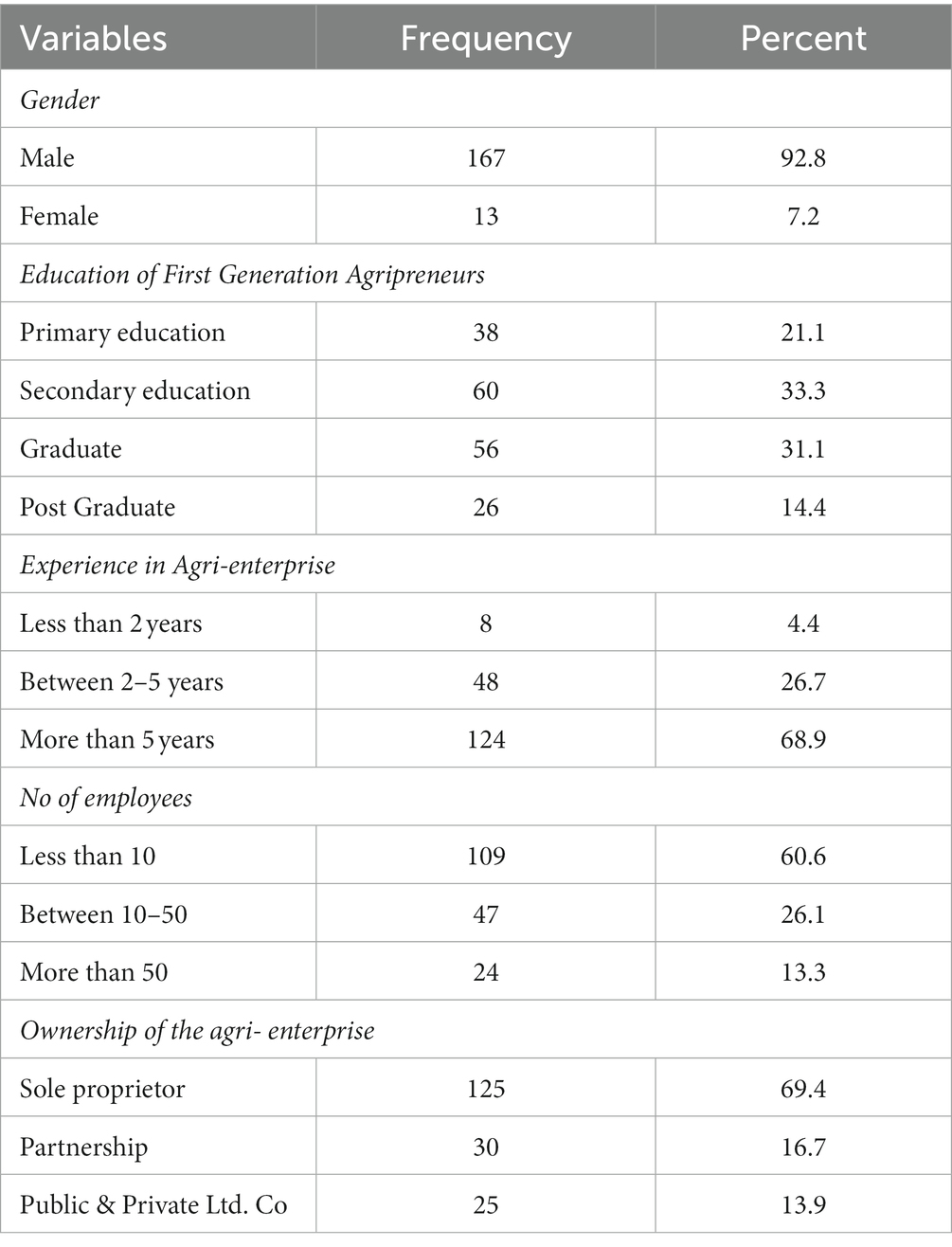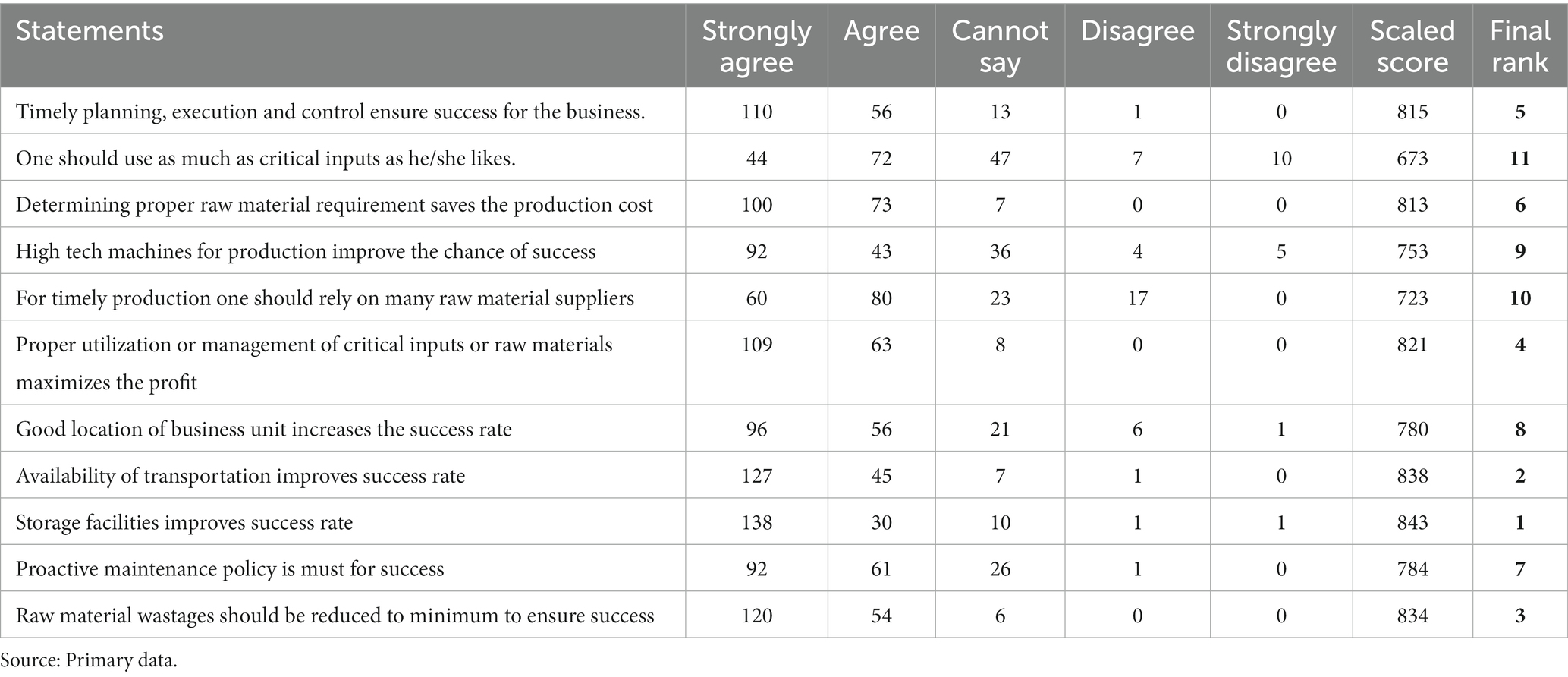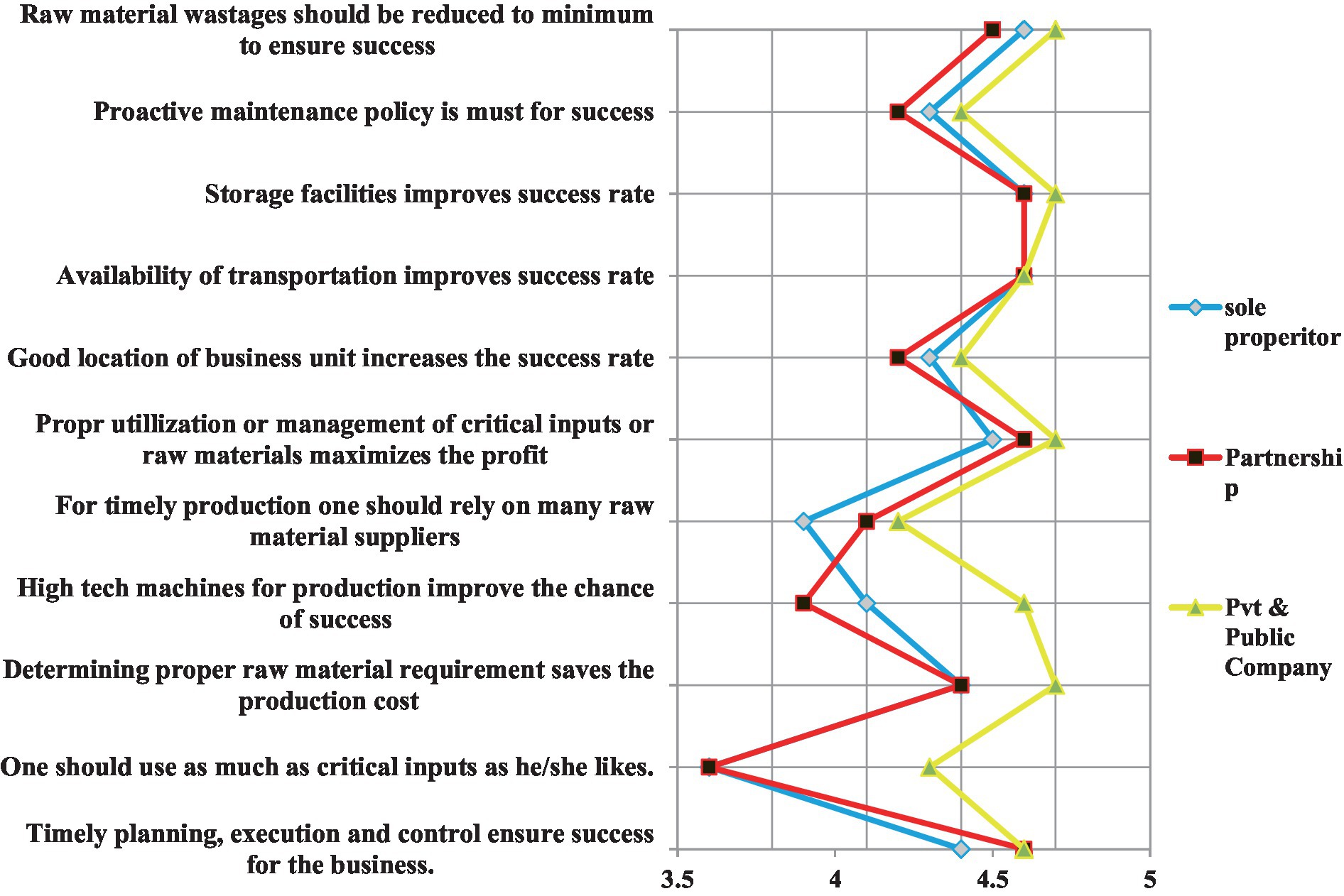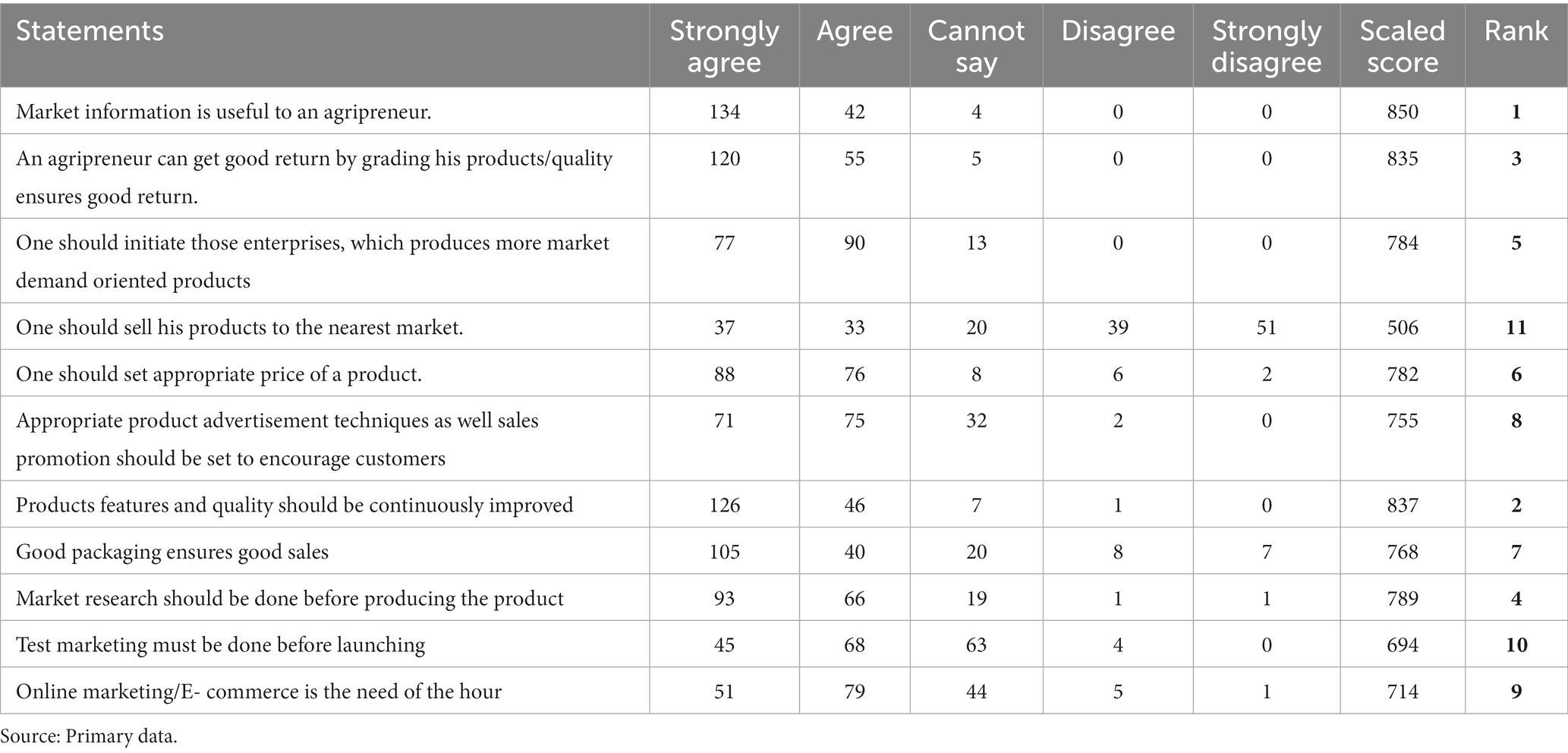- 1Department of Business Management, Maharishi Markandeshwar University, Ambala, India
- 2Department of Agricultural Economics, Chaudhary Charan Singh Haryana Agricultural University, Hisar, India
- 3Head of the Research Resource Center, Ethiopian Civil Service University, Addis Ababa, Ethiopia
India’s economy is based on agriculture, so agricultural entrepreneurship has the potential to boost economic growth, diversify national income, and create many jobs and business opportunities. The goal of this paper, then, is to find out what first-generation agricultural entrepreneurs think about the things that make an agribusiness successful. The data were collected from 22 districts in four geographical zones (East Zone, West Zone, North Zone, and South Zone) in the state of Haryana. Both a 5-point Likert scale and a 7-point semantic differential scale were used to rate the items. The data was looked at using both descriptive statistics and the Friedman nonparametric test. In this study, we found that the majority of first-generation agribusiness owners were men, and they tended to be sole proprietors of small businesses with fewer than 10 employees. The finding also indicates that advanced storage and transportation facilities, market information, product quality, cutting-edge technology, and the careful management of financial resources are the topmost necessities for the successful operation of any agribusiness. The study also found that the size of the firm has a positive and statistically significant impact on the opinions of first-generation agripreneurs on business and production, marketing, competition, and financial and human resource management. The study recommends that policymakers and development agencies should focus on providing support to agripreneurs in terms of infrastructure, market access, and technological advancements. Additionally, efforts should be made to encourage more first-generation agripreneurs to enter the agribusiness sector by providing them with the necessary resources and training.
1. Introduction
Agriculture is the primary source of income and survival for many people living in rural areas (Saghaian et al., 2022). In the agricultural sector, the term “agribusiness” is simply used to refer to the variety of activities and disciplines covered by commercial food production. Agribusiness, or the business of farming, is a branch of agriculture like mushroom cultivation, aquaculture, organic farming, food processing, poultry farming, floriculture, beekeeping, horticulture, and seed supply (Yogesh and Chandrashekar, 2014).
Haryana is one of India’s smaller states, with 4.4 million hectares of land, controlling 1.34 percent of the country’s total geographical area, as well as being a major contributor of 15.6 percent of food cereals to India’s central pool. With the support of agricultural research, strong infrastructure facilities, and an improved network, all such efficient information has been improved, converting the state into a food surplus state (Haryana agribusiness and food processing policy, 2018). Haryana has emerged as a major producer of white button mushrooms, currently ranked first in India in terms of seasonal mushroom cultivation. The rich availability of paddy straw and wheat as well as the easy availability of good quality spawn and holistic training programs offered by the Haryana government have all increased the production of mushrooms. The livestock sector generates approximately 30 percent of the state’s agricultural GDP, and milk and egg production have increased by more than five and 160 times, respectively, since the state was formed. The state also has a high potential for increased cultivation of high-income-generating crops like poultry, sugar, fisheries, and horticulture (Sharma, 2014). India’s economy was primarily agrarian at the time of independence. Agriculture contributed 53.7% of total gross value addition in 1950–51, in terms of real gross value added. Since then, agriculture’s contribution to GDP has been steadily declining, and in percentage terms, the figures for 1990–91 and 2020–21 are 33 percent and 19.9 percent, respectively (GOI, 2021).
Small and medium-sized agricultural enterprises are very important to the growth and development of the world economy, especially in developing economies (Berry et al., 2001; Cook, 2001; Ayyagari et al., 2007; De and Nagaraj, 2014). Agro-industrial companies should be the subject of specific analyses that can elucidate the scope and impact of such differences on their business performance. This is because agro-industrial companies have different management structures and ownership than other types of companies (Lajara-Camilleri and Server Izquierdo, 2015). Some of the emerging themes preferred by modern tech-savvy agripreneurs include the use of crop management, artificial intelligence, harvesting to post-harvest management, smart technologies in cultivation, the use of agribots, precision farming, greenhouse farming, and organic farming (Ajili et al., 2012; Caffaro and Cavallo, 2019). The trend of land ownership is an important factor that ultimately determines the freedom to engage in agricultural activities. It determines agricultural entrepreneurs’ livelihood capabilities and, indirectly, their level of income. Agripreneurs with their own land can only do better business compared to those who cultivate on leased land (Morgan et al., 2010; Yoganandan et al., 2022).
The purpose of the study is to find out about the different types of agricultural business opportunities, such as dairy farming, mushroom growing, beekeeping, seed supply, poultry farming, organic farming, food processing, floriculture, and so on, in a well-known agricultural region in north India. In addition, it will also help in raising awareness about the improved knowledge of important factors related to different areas of management like business and production, marketing, finance, competition, and human resource management, all of which are required for the success of any agribusiness. Many studies have analyzed the impact of different factors on the success of agribusiness, but only a few scholars have focused on the impact of organization size and experience on the above-mentioned factors. Therefore, this study examines the opinions of first-generation agricultural entrepreneurs on the factors that contribute to the success of an agribusiness. Moreover, this study offers valuable contributions by showcasing the significant roles that various agribusinesses, such as mushroom cultivation, poultry farming, aquaculture, floriculture, horticulture, beekeeping, organic farming, and dairy farming, play in boosting productivity and sales of agricultural products. It also highlights how these businesses can contribute to the development and growth of agribusinesses in the long term. The findings of this study can be particularly useful for first-generation agripreneurs who may not be aware of the challenges that affect their personal and professional lives. By focusing on improving their output and leadership abilities, agripreneurs can grow their businesses and contribute to household welfare and poverty reduction in rural areas. The study was conducted in Haryana, a state in North India, which is a significant region for agribusiness, including value-added food production, organic farming, dairy farming, poultry farming, aquaculture, floriculture, horticulture, beekeeping, and more. Despite the state’s success in helping emerging nations, this study serves as a reminder that there is always room for improvement and growth in the agribusiness sector (Garima et al., 2023).
2. Review of literature
Entrepreneurship success is strongly connected with personality attributes (such as adaptability, risk-taking, and discerning), business and managerial knowledge and abilities, and entrepreneurial experience (Ephrem et al., 2021). Murthy and Naikwadi (2015) found that overall investment, education, and government programs that help people are all good for entrepreneurial performance. Sulistyo and Adiatma (2011) say that partnership business plans are made to help small businesses become more self-sufficient by giving them money, training, and improving the knowledge and skills of their human resources. This is done to make sure that the business will still be around in the future. Another study laid out some basic framework for small and medium enterprise managers and owners to reconsider their potential and capability to incorporate competitive enterprise activities into enterprise operations in order to compete in the global market. It requires organizations to look for new technologies, ways to make decisions, and production systems. This is because the business environment can be seen as a single village where many firms compete for business in a single battle (Ziyae and Sadeghi, 2020; Abdissa et al., 2021). To take advantage of market opportunities before their competitors, managers need to be decisive, creative, and proactive. They also need to be willing to take calculated and acceptable risks (Abdissa et al., 2021). Overall investment, education, and government assistance programs are all factors that have a positive impact on entrepreneurial performance (Fatimah-Salwa et al., 2013). Another element that significantly affects the success of agribusiness entrepreneurial endeavours is microcredit financing (Carter and Shaw, 2006). Yeboah et al. (2011) also suggest that resource characteristics, personality type and tendencies, product/service mix, market characteristics, and financial management are significant variables for both business and farm success.
Also, today’s tough business competition makes it more likely that agripreneurs, business owners, and managers will come up with new products, marketing techniques, and processes that will help their businesses do better and take advantage of market opportunities (Luo et al., 2005). Another study’s results revealed that business size directly influences participation in agribusiness. The study also allotted the highest rank amongst other factors to marketing factors, followed by economic and social factors in determining the significance of agri-preneurship development (Agarwal, 2020). Profitability declined at similar rates for both small and large enterprises, while efficiency and leverage varied in opposite directions. Large enterprises may be predicted to continue improving asset utilization while losing relative profitability and increasing their debt-to-equity ratio (Lerman and Parliament, 1991). Mitra and Devi (2016), focused on India’s organic horticulture. According to their findings, the export of organic goods will grow with the help of the government, NGOs, and the industry working together with farmers.
In the US, Canada, Japan, Australia, etc., the market for organic food products is expanding quickly. As a result, the organic food industry has a ton of chances in developing nations to boost exports to industrialized nations. The duration of agribusiness operations overall determines the growth and performance of the business (Sleuwaegen and Goedhuys, 2002). There are several factors that can influence a person’s decision to start their own business. These include their level of education and qualifications in their professional field, the resources available to them through their family, and their current work environment (Berglann et al., 2011). In terms of achieving success as an entrepreneur, those with prior experience in management, a family history of successful entrepreneurship, practical knowledge, and access to employees with specialized skills tend to perform better (Staniewski, 2016).
According to Bannor et al. (2021), farm size has a positive influence on agribusiness fulfillment. Furthermore, numerous studies have found that the size of the organization is significantly related to agricultural entrepreneurs’ success (Antoncic, 2009; Lucas, 2017). The size of an organization indicates the amount of land that is devoted to the production of food and other crops, which helps assess the agribusiness’s production capacity and business operation volume. It also demonstrates the farm’s potential for income (Weaver, 1977). Organic farming, a more widely recognized form of the circular economy, is demonstrating promising trends in Serbia. An integrated agricultural system is still required to reduce the use of fertilizers and pesticides while also redirecting energy away from harmful resources used in food production. Despite having the best results in terms of circular agriculture, Albania has room for improvement in terms of socioeconomic factors. As a result, it is necessary to shift away from extensive labor and toward autonomous force (Vasa et al., 2017).
Entrepreneurs are important to the growth and success of a country’s economy (Valliere and Peterson, 2009). The study by Saghaian et al. (2022) also reveals that an entrepreneur’s previous business experience, interest rates, willingness to take risks, and the amount of money they start with all have a significant impact on their chances of success and making money. But some of the things that made an entrepreneur successful did not have much of an effect on how profitable their business was. The amount of money an entrepreneur started with and the business climate had a big effect on how successful they were, but they did not have much of an effect on how much money they made. Entrepreneurial success is a matter of opinion, which may be related to how well the company meets or exceeds its goals. Academics have had a hard time telling the difference between success and performance, especially since “success can be defined in terms of certain performance elements.” Even though academics are very interested in figuring out what makes SMEs successful (Simpson et al., 2012), it is still a difficult and complex task for many reasons.
3. Research methodology
The goal of this study is to find out what first-generation agricultural entrepreneurs think about the things that make an agribusiness successful. The data was collected from 22 districts in four geographical zones (East Zone, West Zone, North Zone, and South Zone) in the state of Haryana. Both a 5-point Likert scale and a 7-point semantic differential scale were used to rate the items. The collected data was analyzed using both descriptive statistics and the Friedman nonparametric test methods. The study looked at agripreneurs in various agribusinesses such as mushroom cultivation, dairy farming, aquaculture, beekeeping, poultry farming, horticulture, floriculture, organic farming, food processing, and medicinal plants. Rankings were used to determine the first generation agripreneurs’ responses. Each statement’s individual aggregate total weighted score has been determined. The highest scores were assigned the highest rank, with the top rank receiving the maximum score.
3.1. Friedman test
Nonparametric methods are valid statistical branch that studies data which can be measured on an ordinal or nominal scale but cannot be analysed by using arithmetic operations (Conover, 1999). The Friedman test is more useful nonparametric statistical tests and commonly used by many scholars (Petrović et al., 2019; Liu, 2021). The competence and other variables used in our data are referred to as treatments. The responses of one person to these variables are collected in a block. The data can be organised in to table with columns representing treatments and rows containing one person’s answer with two assumptions that the data must meet. To begin, the variables must be mutually independent, which means that the results of one block cannot influence the result of another (Conover, 1999; Porkka et al., 2008). The Friedman test must rank K algorithms on each dataset based on the absolute value of the results produced by these algorithms. The algorithm with the best performance is ranked 1 and the one with the worst performance is ranked K. The statistic’s value is then calculated based on all rankings, as shown in Eqs 1, 2, where rji is the ranking of the j-th algorithm’s performance on the i-th dataset. With K-1 degree of freedom, this statistic follows the chi-square distribution (Friedman, 1937; Friedman, 1940; Liu and Xu, 2022).
4. Result and discussion
4.1. Demographic profile
According to the respondent’s demographic profile, out of 180 respondents who participated in the survey, 167 (92.8%) were male agripreneurs, while the remaining 13 (7.2%) were female agripreneurs. The most respondents (60, or 33.3%) had at least a high school diploma, and the fewest (26, or 14.4%) had a post-graduate degree. As exhibited in Table 1, the agripreneurs in the study have more than 5 years’ experience in agricultural entrepreneurship, and 8 (4.4%) were found to have less than 2 years’ experience in agricultural entrepreneurship. In this study, the first generation of agripreneurs found that most of them had less than 10 people working for them, and only 24 (13.3%) had more than 50 people working for them. Another piece of information concerning the demographic characteristics of first generation agripreneurs concerned agri-enterprise ownership. The majority of 125 (69.4%) respondents were sole-proprietors and a small percentage of 25 (13.9%) had private and public limited companies in Haryana state, India. Another study revealed that the majority of agripreneurs use the sole proprietorship type of business organization to carry out their duties. 74% of the agribusiness in the study was owned by sole traders, and the remaining 26% of respondents used a partnership business structure (Agarwal, 2020).
4.2. Opinions of first generation agripreneurs on business and production
Table 2 shows the rank ordering of First-Generation Agripreneurs’ opinions on businesses and production. It depicts that among all the eleven statements, “Storage facilities improve success rate” was ranked first by the majority of First -Generation Agripreneurs with the highest scaled score of 843. It may be due to the perishable nature of agricultural products. The statement “Availability of transportation improves success rate” was ranked second with a scaled score of 838, followed by the statement “Raw material wastages should be kept to a minimum to ensure success” as the third highest rank and the statement “Proper utilization and management of critical inputs or raw materials maximizes profit” as the fourth highest rank, with 815 and 813, respectively. In order to succeed in agribusiness, storage and transportation facilities should be improved, and raw material waste should be reduced.
4.2.1. Impact of type of ownership size on opinions of the first generation agripreneurs on business and production
Table 3 shows that “Availability of transportation improves success rate,” “Storage facilities improve success rate,” and “Raw material wastages should be kept to a minimum to ensure success” were the most valuable opinions on business and production for sole proprietor first-generation agripreneurs, with an average value of 4.6, and “One should use as much critical inputs as he/she likes” was the least valuable opinion, with an average value of 3.6. In the case of a partnership, the first generation of agripreneurs considered the topmost valuable opinions “Timely planning, execution, and control ensure success for the business,” “proper utilization or management of critical inputs or raw materials maximizes the profit,” Availability of transportation improves success rates,” and “Storage facilities improve success rates,” with 4.6 average scores each, and minimal to “One should use as much critical input as he/she likes.” with an average value of 3.6. The First Generation Agripreneurs of private and public limited enterprises ranked “Determining proper raw material requirements saves production cost,” “Proper utilization or management of critical inputs or raw materials maximizes profit,” and “Storage facilities improve success rate” as highly valuable opinions with an average value of 4.7 each, and “For timely production, one should rely on many raw material suppliers” as the least valuable opinion.
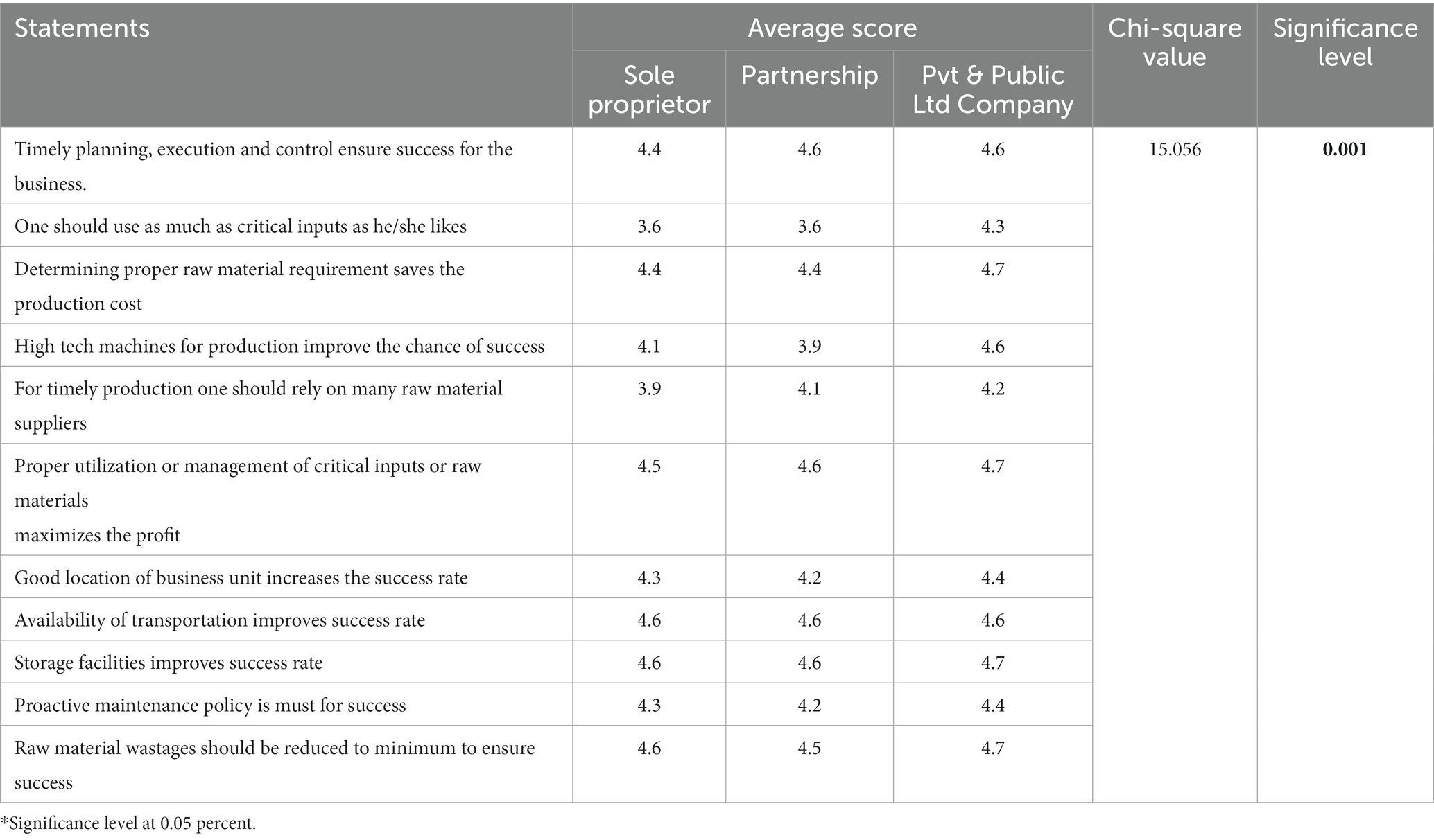
Table 3. Relationship between type of ownership and opinions of first generation agripreneurs on business and production.
The results of the association of type of ownership with first generation agripreneurs’ opinions on business and production, as shown in Table 3, have been interpreted and displayed in Figure 1 using a semantic differential scale.
H01: The type of ownership has no significant effect on the opinions of first-generation agripreneurs regarding their business and production.
This hypothesis has been formulated and tested using Friedman test. The calculated value of chi-square at 0.05 per cent level of significance was 15.056 while tabulated value was 5.991. Based on the data, it is evident that the calculated value (15.056) exceeds the tabulated value (5.991), and the p value is 0.001. This strongly suggests that the type of ownership has a significant influence on the opinions of the first-generation agripreneurs regarding business and production. As a result, the null hypothesis (H01) has been rejected.
The findings of this study provide valuable insights into the relationship between ownership and agripreneurial perspectives, highlighting the importance of considering ownership as a crucial factor in understanding the dynamics of the agricultural industry. Furthermore, these results have implications for policymakers and stakeholders. They can use this information to develop policies and strategies that address the impact of ownership on the agricultural industry.
4.3. Opinions of first generation agripreneurs on competition
Table 4 lists the rankings of first-generation agripreneurs’ perspectives on competition. The results indicates that mostly agripreneurs ranked first to “Better technology and constant improvement make the venture successful” with highest scaled scored 821 among all the other opinions, followed by 768 scaled score with second highest rank attained by “Research & development and innovations are success to key” and remaining ranks 3, 4 and 5 were obtained by “Building brand is key to success,” “The business should have a competitive advantage over others,” and “Competitor’s moves must be tracked” with scaled scores of 746, 719, and 704, respectively. Therefore, better technology, research, and development should be used, and building a brand and competitive advantage as well as tracking competitors’ methods should also be considered to get success in agribusiness.
4.3.1. Effect of type of ownership on opinions of the first generation agripreneurs on competition
According to Table 4, the most valuable opinion of the agripreneurs on competition while running the enterprise solely was “Better technology and constant improvement make the venture successful,” with an average value of 4.5, and the least valuable opinion was “Competitor’s moves must be tracked.” with a 3.8 average value. In the case of collaboration, agripreneurs rated the most valuable opinion as “Better technology and constant improvement make the venture successful” with a 4.5 average score and the least valuable opinion as “Competitor’s moves must be tracked” with a 3.9 average score. First-generation agripreneurs in both private and public limited companies thought that “better technology and constant improvement make the venture successful” was the most valuable opinion on competition, with an average value of 4.7, and that “building a brand is the key to success” was the least valuable opinion, with an average value of 4.2.
Using the semantic differential scale, the results in Table 5 about the relationship between the type of ownership and how first-generation agripreneurs feel about competition have been interpreted and shown in Figure 2.

Table 5. Relationship between type of ownership and opinions of first generation agripreneurs on competition.
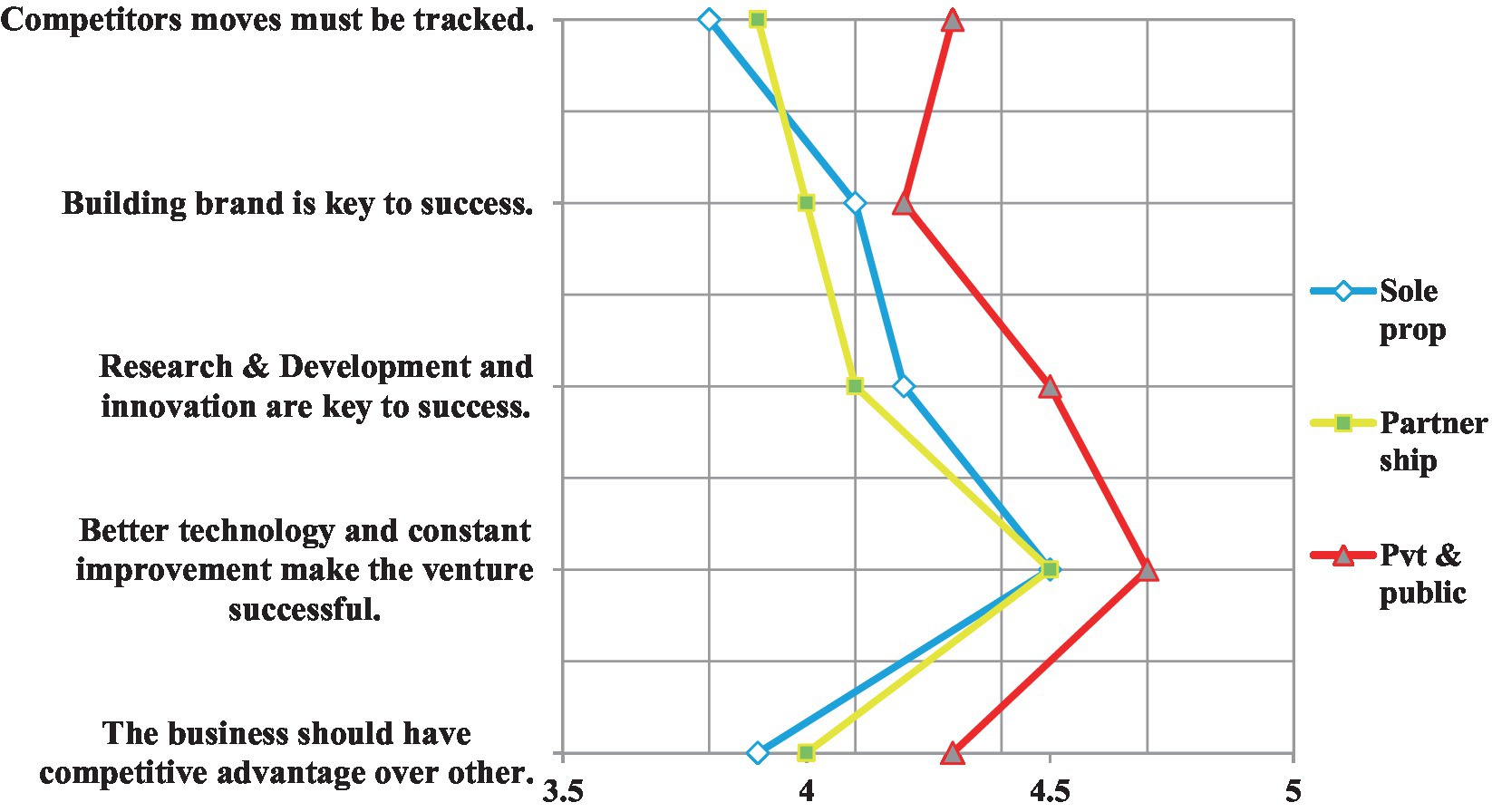
Figure 2. Relationship between type of ownership and opinions of first generation agripreneurs on competition.
4.4. Opinions of first generation agripreneurs on marketing
The majority of first generation agripreneurs believe that “market information is valuable to an agripreneur” is the most crucial belief among the eleven critical beliefs given in Table 6 and has the highest scaled score of 850. The opinion that “product features and quality should be continuously improved” came in second with a scaled score of 837, while the opinion that “one should initiate those enterprises, which produces more market demand oriented products” came in third with a scaled score of 835, and the opinion that “market research should be done before producing the product” came in fourth with a scaled score of 789. However, agricultural entrepreneurs ranked the following as least important: “One should set an appropriate price for a product,” “Good packaging ensures good sales,” “Appropriate product advertisement techniques as well as sales promotion should be set to encourage customers,” “Online marketing/E-commerce is the need of the hour,” and “Test marketing must be done before launching.” These items received scaled scores of 782, 768, 755, 714, and 694, respectively. To thrive in the agribusiness, market information, product quality, prior market research, an acceptable price, good packaging, sales promotion, internet marketing, and test marketing should all be implemented.
In Table 7 the first generation sole proprietor agripreneurs concluded that “Market information is useful to an agripreneur” had the highest average value of 4.7 of all the viewpoints on marketing, and that “One should sell his products to the nearest market” had the lowest average value of 2.7. In the event of a partnership, the first generation of agripreneurs ranked “Market information is important to an agripreneur” as having the highest average score of 4.6 and “One should sell his products to the nearest market” as having the lowest average score of 2.7. First-generation agripreneurs of private and public limited companies rated “Market information is useful to an agripreneur” and “An agripreneur can get good return by grading his product/quality ensures good return” as highly valuable opinions among all other opinions with an average value of 4.8 each, and “One should sell his products to the nearest market.” as the least valuable opinion with an average value of 3.2 each (see Figure 3).
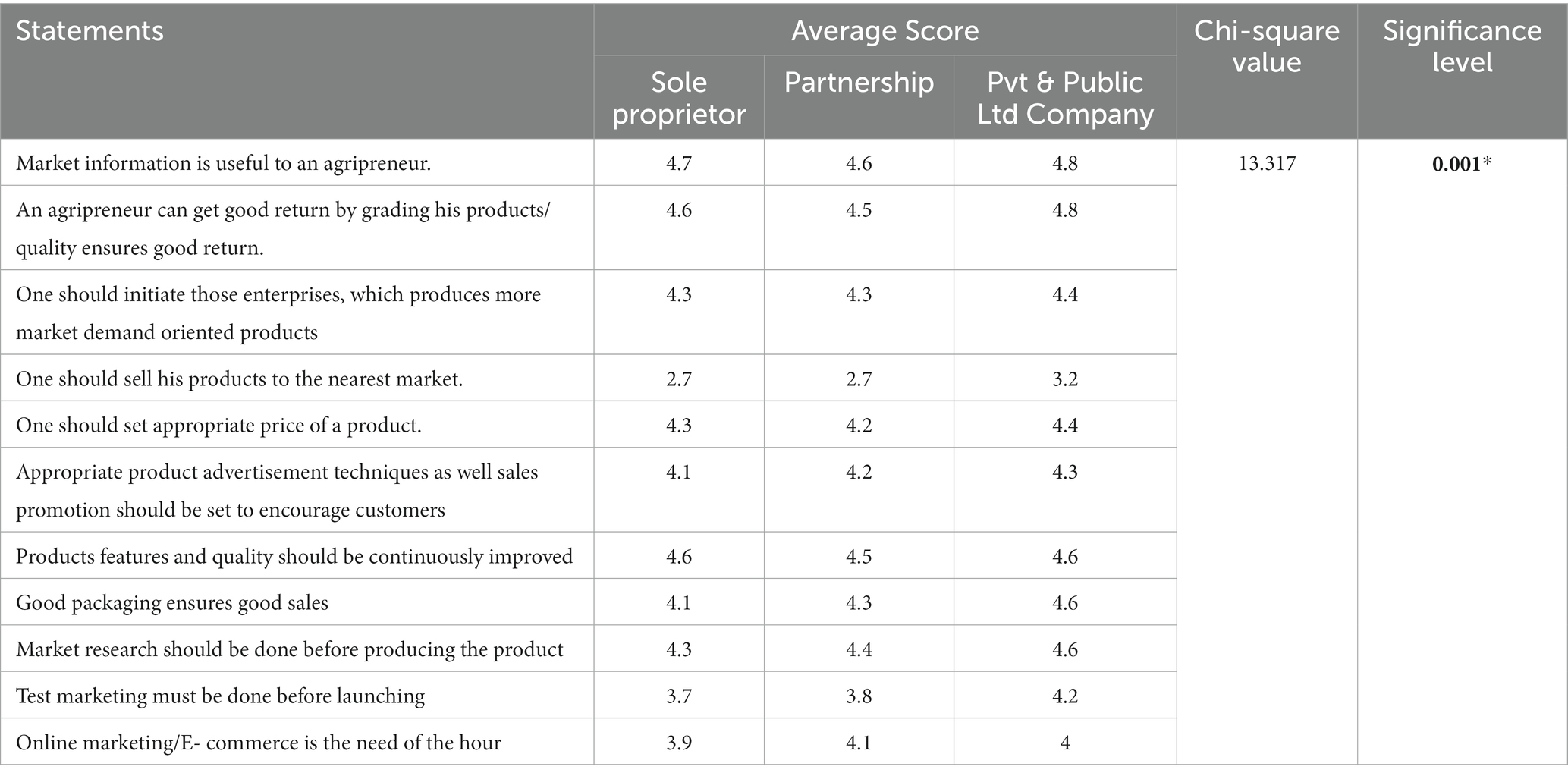
Table 7. Relationship between type of ownership and opinions of first generation agripreneurs on marketing.
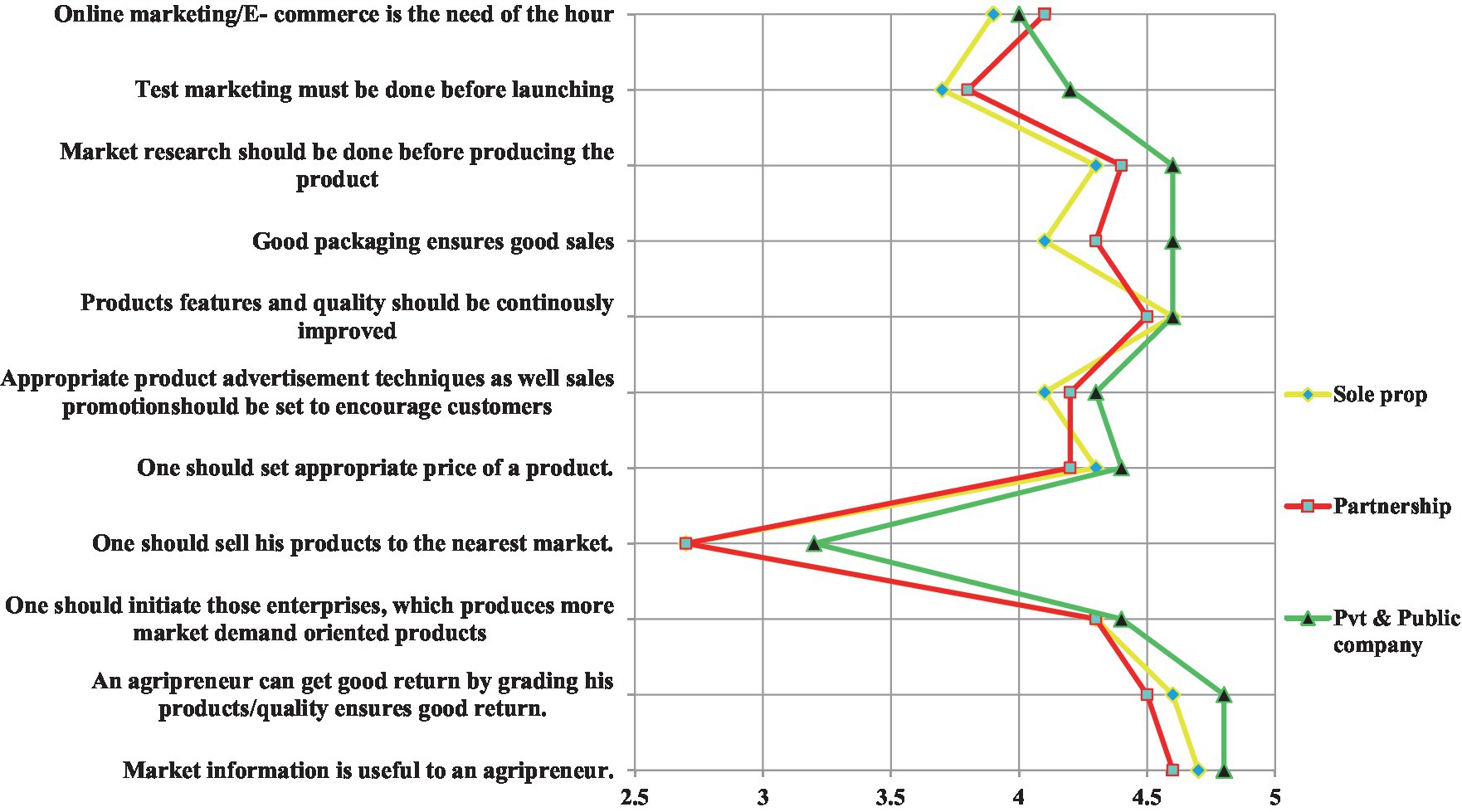
Figure 3. Relationship between type of ownership and opinions of first generation agripreneurs on Marketing.
4.5. Opinions of first generation agripreneurs on finance and human resource management
Amongst the seven important opinions listed in Table 8, the majority of first generation agripreneurs ranked “Managing finance effectively is equally necessary” as the most crucial opinion for agricultural operations, with a scaled score of 822, out of the seven critical opinions stated in Table “Skilled labor resources are essential for success,” with a scaled score of 820, came in second, followed by “Adequate financial resources are essential for success,” in third, and the remaining rankings of “Training and development play significant role for success,” “One should take care of employee’s salary, benefits, and bonus,” “Motivated employees enhance productivity,” and “Employee grievance must be addressed” came in fourth through seventh place.
It is clear from Table 8 that first-generation agripreneurs who operate their businesses solely rated “Skilled manpower/labour resources are also essential for success” as having the highest value out of all the agripreneurs’ opinions on financial and human resource management, with an average value of 4.5, and “Employee grievance must be addressed” having the lowest value, with an average value of 4.3. In the case of partnerships, the first generation of agripreneurs ranked “Training and development play significant role for success” and “Managing finances appropriately is also essential” with average scores of 4.7 and 4.2, respectively. The least valuable opinion was “Employees grievance must be addressed.” Among all other opinions on finance and human resource management, the first generation of agripreneurs of private and public limited enterprises rated “Skilled manpower/labor resources are also essential for success” as having a highly valuable opinion with an average value of 4.8 and “Employees grievance must be addressed” as having a minimally valuable opinion with an average value of 4.5.
H02: The type of ownership has no significant effect on the opinions of first-generation agripreneurs regarding their finance and human resource management.
After conducting the Friedman test, it was found that the calculated value of the chi-square at the 0.05 percent level of significance was 7.760, while the tabulated value was 5.991. Since the calculated value is higher than the tabulated value and the p-value is 0.021, it can be concluded that the type of ownership has a significant impact on the opinions of first-generation agripreneurs regarding Finance and Human Resource management. Therefore, the null hypothesis (H02) has been rejected (see Figure 4).
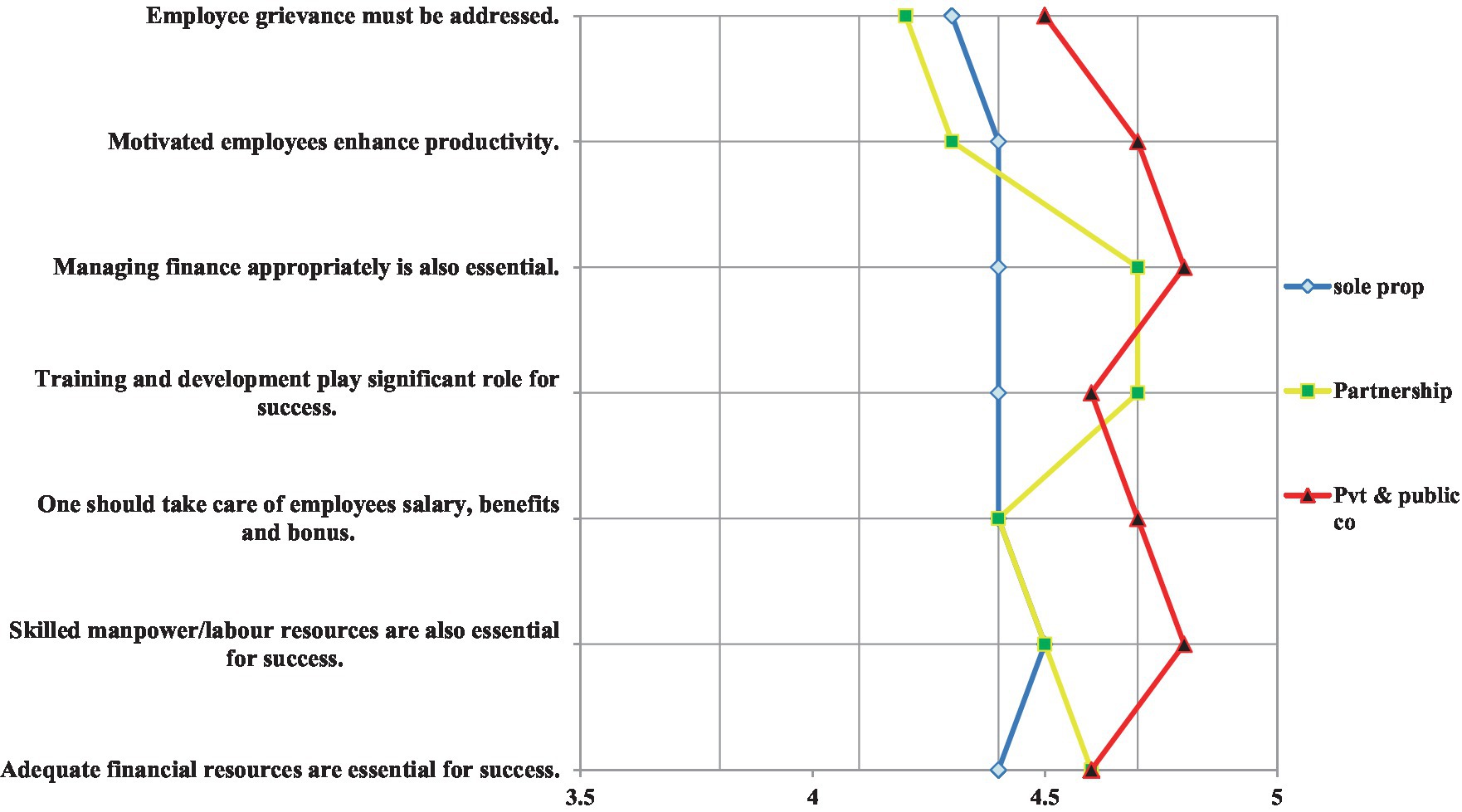
Figure 4. Relationship between type of ownership and opinions of first generation agripreneurs on Finance and Human Resource Management.
5. Discussion
Table 1 shows that the majority of 125 (69.4%) of the respondent agricultural entrepreneurs were found to be sole proprietors, followed by 30 (16.7%) partnership firms, and the remaining 25 (13.9%) had private and public limited companies in Haryana. Other scholars also observed that the majority of agripreneurs fulfilled their responsibilities as sole proprietors in 74% of the agribusinesses in the study. Additionally, it is believed that the agribusiness has a significant and positive effect on its size. The agripreneur is more active in the business as it grows in size. The point is that the larger the business, the greater the opportunities for diversification and reinvestment for the agripreneurs (Agarwal, 2020).
5.1. Business and production
The data in Table 2 enumerates the rank order of the opinions of first generation agribusiness entrepreneurs on business and production. It depicts that among all the eleven statements, “Storage facilities improve success rate” was ranked first by the majority of first generation agripreneurs with the highest scaled score of 843. It may be due to the perishable nature of agricultural products. “Availability of transportation improves success rates” was ranked second.
5.2. Competition
Table 4 lists the rankings of first-generation agripreneurs’ perspectives on competition. The result indicated that most agripreneurs ranked first on “Better technology and constant improvement make the venture successful,” with the highest scaled score of 821 among all the five opinions, followed by a 768 scaled score with the second highest rank attained by “Research & development and innovations are success factors,” as well as a positive impact on organization size of factors opined by first generation agripreneurs related to competition.
Sidhu and Kaur (2006), Bairwa et al. (2014), Verma et al. (2017), and Veni and Lakshmi (2018) all noticed similar trends in their studies. The results of another study showed that the effectiveness of a company’s competitiveness was affected by both internal and external factors (Aydoğan, 2022). Also, they found that small cooperatives were the most successful and that large cooperatives had untapped potential. They also found that the size of an organisation had a positive effect on the profit of businesses (Liang et al., 2022). Another study (Bialoskorski Neto, 1999; Junior and Wander, 2021) shows that both the manufacturing unit and each of its linked production units must be efficient for cooperative ventures to succeed in this new competitive environment. Product acquisition, storage, and marketing are now less economical operations. Therefore, improving the performance of the agro-industrial cooperative venture along the production chain is the only solution (Birchall, 2014). In order to maintain its survival; the company must be able to improve its ability to compete by creating structural and managerial elements that support the strengthening of its position in the market (Lajara-Camilleri and Server Izquierdo, 2015). But the results of the present study indicate that mostly agripreneurs opined to “Better technology and constant improvement make the venture successful,” with the highest scaled score of 821 among all the other opinions.
5.3. Marketing
Among the eleven important opinions listed in Table 7, the majority of first generation agripreneurs found “market information is useful to an agripreneur” to be most important in any agricultural enterprise with the highest scaled score of 850. The opinion that “product features and quality should be continuously improved” came in second, and there was a significant relationship between organization size and the opinion of first generation agripreneurs. These findings are in accordance with the results of Rais and Sheoran (2015), Mitra and Devi (2016) in their respective studies. Some of the scholars studied found that the organization’s size has influenced the first generation of agricultural entrepreneurs’ satisfaction positively (Lucas, 2017; Addo, 2018). Furthermore, studies suggest that enterprises can diversify their production by increasing their access to distribution channels (Estevam et al., 2015). Another study revealed that improved marketing techniques are beneficial because producers can remove the effects of seasonality from their income flow or work with higher value goods by increasing their product line, which often makes rural lands that use organizations more profitable (Liu et al., 2019). The difficulty for agribusiness is increasing member satisfaction and communication in order to maintain and expand their membership (Delarmelina and Salles, 2016). The results of the present study revealed that the majority of first generation agripreneurs found “market information is useful to an agripreneur” to be most important in any agricultural enterprise for the success of agribusiness.
5.4. Finance and human resource management
Among the seven important opinions listed in Table 8, the majority of First Generation Agripreneurs believed “Managing finance appropriately is essential,” the most important opinion for agricultural enterprises, with the highest scaled score of 822. “Skilled manpower/labor resources are essential for success,” with a scaled score of 820, came in second place. The results of the studies by Sidhu and Kaur (2006), Bairwa et al. (2014), Verma et al. (2017), and Devi and Krishna (2018) also supported the findings. Furthermore, studies believe that more training programs should be provided to upscale agripreneurs skills and knowledge in micro and small agribusinesses (Chege et al., 2017) (see Table 9).
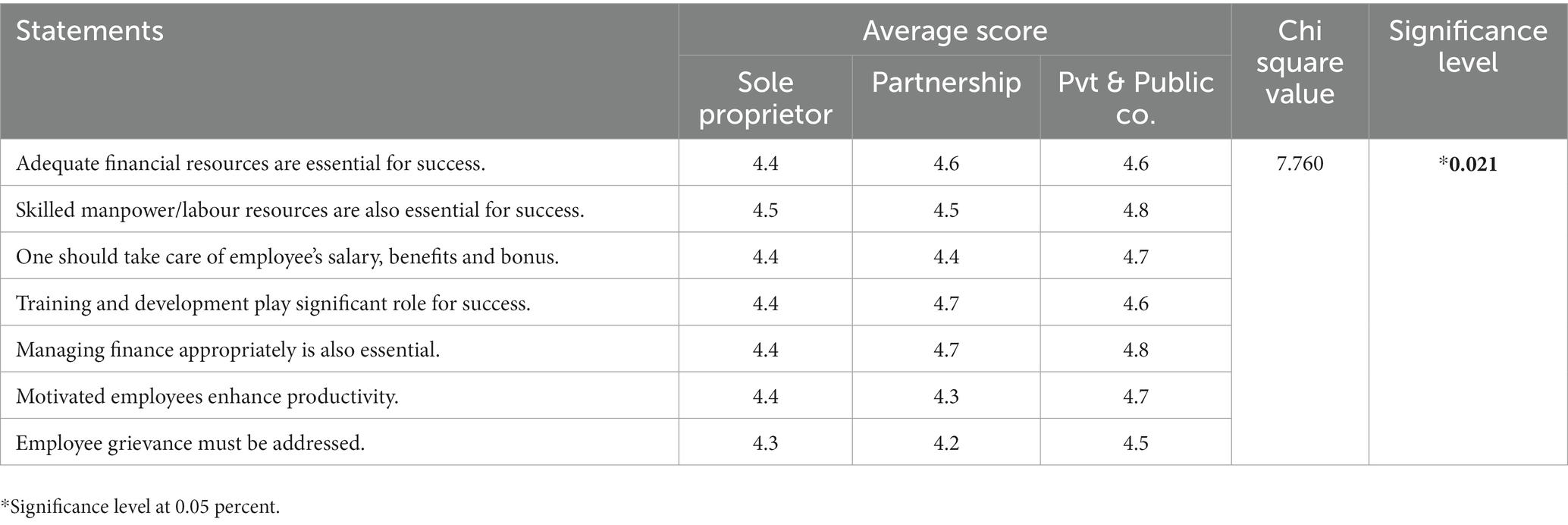
Table 9. Relationship between type of ownership and opinions of first generation agripreneurs on finance and human resource management.
6. Conclusion
According to the majority of first-generation agripreneurs, “market intelligence is valuable to an agripreneur.” The opinion that “product features and quality should be continuously enhanced” came in second, while the opinion that “one should start those businesses, which generates more market demand focused products” came in third. Other significant marketing issues include “One should set the appropriate price of a product,” “Good packaging ensures good sales,” “Appropriate product advertisement techniques as well as sales promotion should be set to encourage customers,” “Online marketing/e-commerce is the need of the hour,” and “Test marketing must be done before launching.” In order to succeed in the agricultural business, it is therefore necessary to improve product quality, gather market information, conduct prior market research, set an appropriate price, use good packaging, promote sales, use online marketing, and conduct test marketing before launching agricultural products. Additionally, staying updated with the latest technological advancements in farming techniques and equipment can greatly enhance productivity and efficiency in the agricultural business.
Furthermore, most of first-generation agricultural entrepreneurs ranked “managing funds effectively is also necessary” as the most crucial factor. The next important statement was “Skilled labour resources are essential for success,” and it was followed by “Adequate financial resources are essential for success.” Other significant statements were, in that order, “Training and development play significant role for success,” “One should take care of an employee’s salary, benefits, and bonus,” “Motivated employees enhance productivity,” and “Employee grievances must be addressed.” According to the study, first-generation agribusiness owners’ perceptions of finance and human resource management are significantly influenced by the form of ownership. Therefore, it is crucial for agribusiness owners to address employee grievances and motivate their employees to increase productivity, as these factors can impact their perceptions of finance and human resource management. Additionally, owners should consider the form of ownership when making decisions related to finance and human resource management. This can help create a positive work environment that fosters productivity and ultimately enhances the owners’ perceptions of finance and human resource management. Moreover, considering the form of ownership allows owners to align their decision-making processes with the unique characteristics and requirements of their business structure, ensuring optimal outcomes in finance and human resource management.
6.1. Limitations and directions for future research
It should be noted that this study has certain limitations, as it solely focuses on qualitative research and incorporates a small sample size. To address these limitations, it is recommended that a more diverse and larger sample from different Indian states be included. Additionally, utilizing both quantitative and qualitative methods could provide a more thorough and extensive analysis.
Data availability statement
The raw data supporting the conclusions of this article will be made available by the authors, without undue reservation.
Ethics statement
Written informed consent was obtained from the individual(s) for the publication of any potentially identifiable images or data included in this article.
Author contributions
Garima: conceptualization, data curation, formal analysis, methodology, and software. AD: formal analysis, methodology, supervision, and validation. DB: conceptualization, formal analysis, and software. HL: writing, review and editing. RL: editing the manuscript. All authors contributed to the article and approved the submitted version.
Conflict of interest
The authors declare that the research was conducted in the absence of any commercial or financial relationships that could be construed as a potential conflict of interest.
Publisher’s note
All claims expressed in this article are solely those of the authors and do not necessarily represent those of their affiliated organizations, or those of the publisher, the editors and the reviewers. Any product that may be evaluated in this article, or claim that may be made by its manufacturer, is not guaranteed or endorsed by the publisher.
References
Abdissa, G., Ayalew, A., Illés, C. B., and Dunay, A. (2021). Effects of corporate entrepreneurship dimensions on organizational performance: case of small and medium Enterprises in Holeta Town, Ethiopia. J. Open Innov. Technol. 7:234. doi: 10.3390/joitmc7040234
Addo, L. K. (2018). Factors influencing Agripreneurship and their role in Agripreneurship performance among young graduate Agripreneurs. Int. J. Environ. Agric. Biotechnol. 3, 2051–2066. doi: 10.22161/ijeab/3.6.14
Agarwal, A. (2020). Entrepreneurship development in agribusiness enterprises a study of garhwal mandal region of uttarakhand state of india. Int. J. Manag. 11:1668–1678.
Ajili, A., Salehi, S., Rezaei-moghaddam, K., Hayati, D., and Karbalaee, F. (2012). Estimating the model of investigating attitude and intention in the usage of variable rate irrigation technology. Am. J. Exp. Agric. 2, 542–556. doi: 10.9734/AJEA/2012/1267
Antoncic, B. (2009). The entrepreneur’s general personality traits and technological developments. World Acad. Sci. Eng. Technol. 53, 236–241.
Aydoğan, M. (2022). Internal factors affecting competitiveness in agribusinesses: a case study in the hazelnut sector in Ordu and Giresun provinces of Turkey. Erwerbs-obstbau 65, 795–805. doi: 10.1007/s10341-022-00784-6
Ayyagari, M., Beck, T., and Demirguc-Kunt, A. (2007). Small and medium enterprises across the globe. Small Bus. Econ. 29, 415–434. doi: 10.1007/s11187-006-9002-5
Bairwa, S. L., Lakra, K., Kushwaha, S., Meena, L. K., and Kumar, P. (2014). Agripreneurship development as a tool to upliftment of agriculture. Int. J. Sci. Res. Publ. 4, 1–4.
Bannor, R. K., Ros-Tonen, M. A., Mensah, P. O., Derkyi, M., and Nassah, V. F. (2021). Entrepreneurial behaviour among non-timber forest product-growing farmers in Ghana: an analysis in support of a reforestation policy. Forest Policy Econ. 122:102331. doi: 10.1016/j.forpol.2020.102331
Berglann, H., Moen, E. R., Røed, K., and Skogstrøm, J. F. (2011). Entrepreneurship: origins and returns. Labour Econ. 18, 180–193. doi: 10.1016/j.labeco.2010.10.002
Berry, A., Rodriguez, E., and Sandee, H. (2001). Small and medium enterprise dynamics in INDONESIA. Bull. Indones. Econ. Stud. 37, 363–384. doi: 10.1080/00074910152669181
Bialoskorski Neto, S. (1999). A nova geração de cooperativas e a coordenação dos sistemas agroindustriais. II Workshop Brasileiro de Gestão de Sistemas Agroindustriais. Ribeirão Preto, SP: FEA/USP.
Birchall, J. (2014). “Innovation in the governance of large co-operative businesses: the alarming case of UK Co-operative group.” in Cooperatives’ Power of Innovation: Texts selected from the international call for papers. Eds. K. L. Hammond and V. M. Robichaud. Levis, Quebec, Canada: International Summit of Cooperatives. 87–97. Avbailable at: https://www.sommetinter.coop/sites/default/files/article-scientifique/files/2014_06_birchall.pdf
Caffaro, F., and Cavallo, E. (2019). The effects of individual variables, farming system characteristics and perceived barriers on actual use of smart farming technologies: evidence from the Piedmont region, Northwestern Italy. Agriculture 9:111. doi: 10.3390/agriculture9050111
Carter, S., and Shaw, E. (2006). Women's business ownership: Recent research and policy developments. London: DTI Small Business Service Research Report.
Chege, D., Ang, N. G., and Gichira, P. R. (2017). Factors affecting growth of agribusiness micro and small enterprises in EMBU County. Strateg. J. Bus. Change Manag. 4, 246–261.
Cook, P. (2001). Finance and small and medium-sized enterprise in developing countries. J. Dev. Entrep. 6:17–40.
De, P. K., and Nagaraj, P. (2014). Productivity and firm size in India. Small Bus. Econ. 42, 891–907. doi: 10.2307/43552966
Delarmelina, N., and Salles, A. O. T. (2016). A study about the commercialization of production from agribusiness cooperatives under the view of transaction costs theory. Custos e Agronegocio 12:34–71.
Devi, V. R., and Krishna, R. (2018). Improving farmer’s income by promoting Agri-preneurship on basis of shared economy principle. Int. J. Pure Appl. Math. 118, 4729–4738.
Ephrem, A. N., Nguezet, P. M. D., Charmant, I. K., Murimbika, M., Awotide, B. A., Tahirou, A., et al. (2021). Entrepreneurial motivation, psychological capital, and business success of young entrepreneurs in the DRC. Sustainability 13:4087. doi: 10.3390/su13084087
Estevam, D. D. O., Salvaro, G. I. J., and Busarello, C. S. (2015). Spaces of production and marketing of family farming: the decentralized cooperatives South Santa Catarina. Interações (Campo Grande) 16, 289–299. doi: 10.1590/151870122015205
Fatimah-Salwa, A. H., Mohamad-Azahari, A., and Joni-Tamkin, B. (2013). Success factors of successful microcredit entrepreneurs: empirical evidence from Malaysia. Int. J. Bus. Soc. Sci. 4, 153–159.
Friedman, M. (1937). The use of ranks to avoid the assumption of normality implicit in the analysis of variance. J. Am. Stat. Assoc. 32, 675–701. doi: 10.1080/01621459.1937.10503522
Friedman, M. (1940). A comparison of alternative tests of significance for the problem of $m$ rankings. Ann. Math. Stat. 11, 86–92. doi: 10.1214/aoms/1177731944
Garima, D. A., Centobelli, P., and Cerchione, R. (2023). Factors and activities considered by first generation Agripreneurs for Agri-business sustainable development: a study of Haryana, India. Sustainability 15:7109. doi: 10.3390/su15097109
GOI. (2021). ‘Ministry of Finance, economic survey 2020–21 statistical appendix ’, Available at: https://www.indiabudget.gov.in/economicsurvey/doc/Statistical-Appendix-in-English.pdf (Accessed May 24, 2021).
Haryana agribusiness and food processing policy. (2018). Haryana Industries. Available at: http://www.haryanaindustries.com/21-Haryana-Agri-Business-and-Food-Processing-Policy-2018.html (Accessed March 13, 2023).
Junior, P. O., and Wander, A. E. (2021). Factors for the success of agricultural cooperatives in Brazil. J. Agric. Rural. Dev. Trop. Subtrop. 122, 27–42. doi: 10.17170/kobra-202102113202
Lajara-Camilleri, N., and Server Izquierdo, R. J. (2015). Orientación al mercado y tipología de las cooperativas agroalimentarias en base a la competitividad. Caso-estudio de las citrícolas españolas. REVESCO. Revista De Estudios Cooperativos 121, 145–172. doi: 10.5209/rev_reve.2016.v121.51305
Lerman, Z., and Parliament, C. (1991). Size and industry effects in the performance of agricultural cooperatives. Agric. Econ. 6, 15–29. doi: 10.1111/j.1574-0862.1991.tb00168.x
Liang, Q., Bai, R., Jin, Z., and Fu, L. (2022). Big and strong or small and beautiful: effects of organization size on the performance of farmer cooperatives in China. Agribusiness 39, 196–213. doi: 10.1002/agr.21767
Liu, J. (2021). Fuzzy support vector machine for imbalanced data with borderline noise. Fuzzy Sets Syst. 413, 64–73. doi: 10.1016/j.fss.2020.07.018
Liu, Y., Ma, W., Renwick, A., and Fu, X. (2019). The role of agricultural cooperatives in serving as a marketing channel: evidence from low-income regions of Sichuan province in China. Int. Food Agribusiness Manag. Rev. 22, 265–282. doi: 10.22434/ifamr2018.0058
Liu, J., and Xu, Y. (2022). T-Friedman test: a new statistical test for multiple comparison with an adjustable conservativeness measure. Int. J. Comput. Intell. Syst. 15:29. doi: 10.1007/s44196-022-00083-8
Lucas, S. (2017). The impact of demographic and social factors on firm performance in Kenya. J. Bus. Econ. Dev. 2, 255–261.
Luo, X., Zhou, L., and Liu, S. S. (2005). Entrepreneurial firms in the context of China’s transition economy: an integrative framework and empirical examination. J. Bus. Res. 58, 277–284. doi: 10.1016/s0148-2963(03)00159-0
Mitra, S., and Devi, H. (2016). Organic horticulture in India. Horticulturae 2:17. doi: 10.3390/horticulturae2040017
Morgan, S. L., Marsden, T., Miele, M., and Morley, A. (2010). Agricultural multifunctionality and farmers’ entrepreneurial skills: a study of Tuscan and welsh farmers. J. Rural. Stud. 26, 116–129. doi: 10.1016/j.jrurstud.2009.09.002
Murthy, M. R. K., and Naikwadi, P. M. (2015). Sustainable Agri-business development and food marketing management-opportunities & challenges in India. Asian J. Res. Marketing 4, 1–12.
Petrović, M., Miljković, Z., and Jokić, A. (2019). A novel methodology for optimal single mobile robot scheduling using whale optimization algorithm. Appl. Soft Comput. 81:105520. doi: 10.1016/j.asoc.2019.105520
Porkka, P., Jussila, J., and Suominen, A. (2008). “Using Friedman test for creating comparable group results of nonparametric innovation competence data” in Proc. present. Pap. 5th Int. Conf. Innov. Manag (Netherlands: Unu-Merit, Maastricht), 722–728.
Rais, M., and Sheoran, A. (2015). Scope of supply chain management in fruits and vegetables in India. J. Food Process. Technol. 6:427. doi: 10.4172/2157-7110.1000427
Saghaian, S., Mohammadi, H., and Mohammadi, M. (2022). Factors affecting success of entrepreneurship in agribusinesses: evidence from the City of Mashhad, Iran. Sustainability 14:7700. doi: 10.3390/su14137700
Sharma, A. (2014). Performance of agriculture and allied sectors in Haryana. J. Econ. Sust. Dev. 5, 39–45.
Sidhu, K., and Kaur, S. (2006). Development of entrepreneurship among rural women. J. Soc. Sci. 13, 147–149. doi: 10.1080/09718923.2006.11892543
Simpson, M., Padmore, J., and Newman, N. (2012). Towards a new model of success and performance in SMEs. Int. J. Entrep. Behav. Res. 18, 264–285. doi: 10.1108/13552551211227675
Sleuwaegen, L., and Goedhuys, M. (2002). Growth of firms in developing countries, evidence from Côte d’Ivoire. J. Dev. Econ. 68, 117–135. doi: 10.1016/s0304-3878(02)00008-1
Staniewski, M. W. (2016). The contribution of business experience and knowledge to successful entrepreneurship. J. Bus. Res. 69, 5147–5152. doi: 10.1016/j.jbusres.2016.04.095
Sulistyo, H., and Adiatma, A. (2011). Model optimalisai kemitraan usaha kecil menengah dan badan usaha milik negara melalui program kemitraan dan bina lingkungan untuk meningkatkan kinerja. Jurnal Ilmu Pengetahuan dan teknologi (IPTEK) 5, 25–40.
Valliere, D., and Peterson, R. (2009). Entrepreneurship and economic growth: evidence from emerging and developed countries. Entrepr. Reg. Dev. 21, 459–480. doi: 10.1080/08985620802332723
Vasa, L., Angeloska, A., and Trendov, N. M. (2017). Comparative analysis of circular agriculture development in selected Western Balkan countries based on sustainable performance indicators. Economic annals-XXI 168, 44–47.
Veni, C. P., and Lakshmi, K. B. (2018). Need for promotion of Agriprenuership to address the challenges in Indian agriculture: a critical review. Int. J. Curr. Microbiol. App. Sci. 7, 2565–2572. doi: 10.20546/ijcmas.2018.710.298
Verma, R. K., Sahoo, A. K., and Rakshit, S. (2017). Opportunities in agripreneurship in India: need challenges and future prospects. Rashtriya Krishi 13, 71–72.
Weaver, C. N. (1977). Relationships among pay, race, sex, occupational prestige, supervision, work autonomy, and job satisfaction in a national sample. Pers. Psychol. 30, 437–445. doi: 10.1111/j.1744-6570.1977.tb00436.x
Yeboah, A. K., Owens, J. P., and Bynum, J. S. (2011). Factors influencing successful small-farm operations in North Carolina (No. 1371–2016-108969). Corpus Christi, TX: Paper presented at the Southern Agricultural Economics Association Annual Meeting. Available at: http://ageconsearch.umn.edu/bitstream/98815/2/Yeboah_NCAT_SAEA2011.pdf
Yoganandan, G., Rahman, A. A. A., Vasan, M., and Meero, A. (2022). Evaluating agripreneurs’ satisfaction: exploring the effect of demographics and emporographics. J. Innov. Entrep. 11, 1–22. doi: 10.1186/s13731-022-00193-9
Yogesh, M. S., and Chandrashekar, H. M. (2014). Opportunities for strengthening of agribusiness sectors in rural India. Int. J. Manag. Res. Rev. 4, 498–508.
Keywords: agribusiness, agripreneurs, success factors, ownership type, firm size
Citation: Dhingra A, Bishnoi DK, Lemma HR and Lamba R (2023) Large and powerful or small and lovely: opinions of first-generation agricultural entrepreneurs on agribusiness success factors. Front. Sustain. Food Syst. 7:1194981. doi: 10.3389/fsufs.2023.1194981
Edited by:
Marzia Ingrassia, Università degli Studi di Palermo, ItalyReviewed by:
László Vasa, Széchenyi István University, HungaryGodfrey Moses Owot, Gulu University, Uganda
Adis Puška, University of Bijeljina, Bosnia and Herzegovina
Copyright © 2023 Garima, Dhingra, Bishnoi, Lemma and Lamba. This is an open-access article distributed under the terms of the Creative Commons Attribution License (CC BY). The use, distribution or reproduction in other forums is permitted, provided the original author(s) and the copyright owner(s) are credited and that the original publication in this journal is cited, in accordance with accepted academic practice. No use, distribution or reproduction is permitted which does not comply with these terms.
*Correspondence: Habtamu R. Lemma, aGFidGFtdXJlZ2Fzc2FAcm9ja2V0bWFpbC5jb20=
 Garima1
Garima1 Habtamu R. Lemma
Habtamu R. Lemma